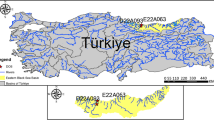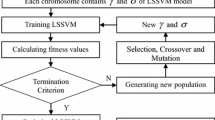Abstract
Landslides occur frequently in the Three Gorges in China, posing threats to human life and the normal operation of the Three Gorges Dam. A number of preexisting landslides have been reactivated since the initial impoundment of the Three Gorges Reservoir in June 2003. An effective and accurate method of predicting landslide displacement is necessary to mitigate the effects of these disastrous landslides. This study carries out a landslide displacement prediction for the Shuping landslide using 7 years of monitoring data, wavelet analysis, and a particle swarm-optimized support vector machine (PSO-SVM) model. The landslide’s displacement is strongly influenced by periodic precipitation and reservoir level fluctuations, and the cumulative displacement curve versus time indicates a step-like character. Based on the deformation characteristics of this landslide, the total displacement is divided into its trend and periodic components by means of the wavelet analysis. An S-curve estimation is used to predict the trend displacement via the curve fitting of the historical displacement versus time. Five primary factors are used as the input variables for a PSO-SVM model to predict periodic displacement. These factors include cumulative precipitation over the previous month, cumulative precipitation during a two-month period, maximum continuous decrement in the reservoir level during the current month, and cumulative increments and decrements in the reservoir level during the current month. The mean squared error, squared correlation coefficient, and Akaike’s information criterion of the wavelet-PSO-SVM model at GPS monitoring points ZG85 and ZG87 are 2.45, 0.945, and 20.80 and 10.46, 80.981, and 36.38, respectively. This method can be applied to the prediction of displacement in colluvial landslides in the Three Gorges. This study may provide useful information to engineers and planners involved in landslide prevention and reduction.



















Similar content being viewed by others
References
Abdi MJ, Giveki D (2013) Automatic detection of erythemato-squamous diseases using PSO–SVM based on association rules. Eng Appl Artif Intel 26:603–608
Bai YA, Xu HL, Ling HB (2014) Drought-flood variation and its correlation with runoff in three headstreams of Tarim River, Xinjiang. China. Environ Earth Sci 71(3):1297–1309
Bui DT, Pradhan B, Lofman O, Revhaug I (2012) Landslide susceptibility assessment in Vietnam using support vector machines, decision tree and Naïve Bayes models. Math Probl Eng. doi:10.1155/2012/974638
Chen H, Zeng Z (2013) Deformation prediction of landslide based on improved back-propagation neural network. Cogn Comput 5(1):55–62
Daubechies I (1992) Ten lectures on wavelets. Society for industrial and applied mathematics, Philadelphia
Doglioni A, Simeone V (2014) Geomorphometric analysis based on discrete wavelet transform. Environ Earth Sci 71(7):3095–3108
Dong H, Fu H, Feng W, Deng Z (2007) Landslide displacement prediction based on Takens theory and SVM. China J Highw Transp 20(5):13–18
Du J, Yin K, Lacasse S (2013) Displacement prediction in colluvial landslides, Three Gorges Reservoir, China. Landslides 10:203–218
Ebadi L, Shafri HZM, Mansor SB, Ashurov R (2013) A review of applying second-generation wavelets for noise removal from remote sensing data. Environ Earth Sci 70(6):2679–2690
Fan Q, Hua X (2009) A novel method for forecasting landslide displacement based on phase space reconstruction and support vector machine. Geomat Inf Sc Wuhan Univ 34(2):248–251
Helmstetter A, Sornette D, Grasso JR, Andersen JV, Gluzman S, Pisarenko V (2004) Slider block friction model for landslides: application to Vaiont and La Clapière landslides. J Geophys Res 109(B02409):1–15
Ilhan I, Tezel G (2013) A genetic algorithm–support vector machine method with parameter optimization for selecting the tag SNPs. J Biomed Inform 46:328–340
Keefer DK, Wilson RC, Mark RK, Brabb EE, Brown WM, Ellen SD, Harp EL, Wieczorek GF, Alger CS, Zatkin RS (1987) Real-time landslide warning during heavy rainfall. Science 238:921–925
Keerthi SS, Lin CJ (2003) Asymptotic behaviors of support vector machines with gaussian kernel. Neural Comput 15:1667–1689
Kennedy J, Eberhart RC (1995) Particle swarm optimization. Proc IEEE Int Conf Neural Netw 4:1942–1948
Khazaee A, Ebrahimzadeh A (2010) Classification of electrocardiogram signals with support vector machines and genetic algorithms using power spectral features. J Biomed Inform 5:252–263
Li X, Kong J (2014) Application of GA-SVM method with parameter optimization for landslide development prediction. Nat Hazards Earth Syst Sci 14(3):525–533. doi:10.5194/nhess-14-525-2014
Li C, Tang H, Hu X, Li D, Hu B (2009) Landslide prediction based on wavelet analysis and cusp catastrophe. J Earth Sci-China 20(6):971–977
Li X, Kong J, Wang Z (2012) Landslide displacement prediction based on combining method with optimal weight. Nat Hazards 61(2):635–646
Lin YB, Lin YP, Deng DP, Chen KW (2008) Integrating remote sensing data with directional two-dimensional wavelet analysis and open geospatial techniques for efficient disaster monitoring and management. Sensors 8(2):1070–1089
Lins ID, Moura MC, Zio E, Droguett EL (2012) A particle swarm-optimized support vector machine for reliability prediction. Qual Reliab Eng Int 28:141–158
Liu JG, Mason PJ, Clerici N, Chen S, Davis A, Miao F, Deng H, Liang L (2004) Landslide hazard assessment in the Three Gorges area of the Yangtze river using ASTER imagery: Zigui-Badong. Geomorphology 61:171–187
Liu Z, Xu W, Shao J (2012) Gaussian process based approach for application on landslide displacement analysis and prediction. Comput Model Eng 84(2):99–122
Liu Z, Shao J, Xu W, Chen H, Shi C (2013) Comparison on landslide nonlinear displacement analysis and prediction with computational intelligence approaches. Landslides. doi:10.1007/s10346-013-0443-z
Lu P, Rosenbaum MS (2003) Artificial neural networks and grey systems for the prediction of slope stability. Nat Hazards 30:383–398
Lv Y, Liu H (2012) Prediction of landslide displacement using grey and artificial neural network theories. Adv Sci Lett 11(1):511–514
Matías JM, Taboada J, Ordóñez C, González-Manteiga W (2010) Partially linear support vector machines applied to the prediction of mine slope movements. Math Comput Model 51(3–4):206–215
Micheletti N, Foresti L, Kanevski M, Pedrazzini A, Jaboyedoff M (2011) Landslide susceptibility mapping using adaptive Support Vector Machines and feature selection. Geophys Res Abstr, EGU 13
Min JH, Lee YC (2005) Bankruptcy prediction using support vector machine with optimal choice of kernel function parameters. Expert Syst Appl 28(4):603–614
Mufundirwa A, Fujii Y, Kodama J (2010) A new practical method for prediction of geomechanical failure time. Int J Rock Mech Min Sci 47(7):1079–1090
Peng J, Shen H, He SW, Wu JS (2013a) Soil moisture retrieving using hyperspectral data with the application of wavelet analysis. Environ Earth Sci 69(1):279–288
Peng L, Niu R, Zhao Y, Deng Q (2013b) Prediction of landslide displacement based on KPCA and PSO-SVR. Geomat Inf Sci Wuhan Univ 38(2):148–152
Pradhan B (2010a) Landslide susceptibility mapping of a catchment area using frequency ratio, fuzzy logic and multivariate logistic regression approaches. J Indian Soc Remote Sens 38(2):301–320
Pradhan B (2010b) Remote sensing and GIS-based landslide hazard analysis and cross-validation using multivariate logistic regression model on three test areas in Malaysia. Adv Space Res 45(10):1244–1256
Pradhan B, Youssef AM, Varathrajoo R (2010a) Approaches for delineating landslide hazard areas using different training sites in an advanced artificial neural network model. Geo-Spatial Inf Sci 13(2):93–102
Pradhan B, Oh HJ, Buchroithner M (2010b) Weights-of-evidence model applied to landslide susceptibility mapping in a tropical hilly area. Geomat Nat Hazards Risk 1(3):199–223
Pradhan B, Mansor S, Pirasteh S, Buchroithner MF (2011) Landslide hazard and risk analyses at a landslide prone catchment area using statistical based geospatial model. Int J Remote Sens 32(14):4075–4087
Randall WJ (2007) Regression models for estimating coseismic landslide displacement. Eng Geol 91(2–4):209–218
Subasi A (2013) Classification of EMG signals using PSO optimized SVM for diagnosis of neuromuscular disorders. Comput Biol Med 43:576–586
Vapnik V (1995) Nature of statistical learning theory. Wiley, New York
Wang JF (2003) Quantitative prediction of landslide using S-curve. Chin J Geol Hazard Control 14:1–8
Wang F, Zhang Y, Huo Z, Peng X, Araiba K, Wang G (2008) Movement of the Shuping landslide in the first 4 years after the initial impoundment of the Three Gorges Dam Reservoir. China Landslides 5(3):321–329
Wu CH, Tzeng GH, Goo YJ, Fand WC (2007) A real-valued genetic algorithm to optimize the parameters of support vector machine for predicting bankruptcy. Expert Syst Appl 32:397–408
Xia M, Ren GM, Ma XL (2013) Deformation and mechanism of landslide influenced by the effects of reservoir water and rainfall, Three Gorges, China. Nat Hazards 68:467–482
Xu Q, Tang M, Xu K, Huang X (2008) Research on space–time evolution laws and early warning-prediction of landslides. Chin Journal Rock Mech and Eng 27:1104–1112
Zhu C, Hu G (2013) Time series prediction of landslide displacement using SVM model: application to Baishuihe landslide in Three Gorges reservoir area, China. Appl Mech Mater 239–240:1413–1420
Acknowledgments
Thanks for Dr. LaMoreaux and three anonymous reviewers for their valuable comments. This study is jointly supported by the NSFC (41271455/D0108), the Open Research Fund of State Key Laboratory of Information Engineering in Surveying, Mapping and Remote Sensing (13S01), and state 863 Program (Grant No. 2012AA121303). The authors would also like to thank the members of the Administration of Prevention and Control of Geo-Hazards in the Three Gorges Reservoir of China for their assistance in data collection.
Author information
Authors and Affiliations
Corresponding author
Rights and permissions
About this article
Cite this article
Ren, F., Wu, X., Zhang, K. et al. Application of wavelet analysis and a particle swarm-optimized support vector machine to predict the displacement of the Shuping landslide in the Three Gorges, China. Environ Earth Sci 73, 4791–4804 (2015). https://doi.org/10.1007/s12665-014-3764-x
Received:
Accepted:
Published:
Issue Date:
DOI: https://doi.org/10.1007/s12665-014-3764-x




